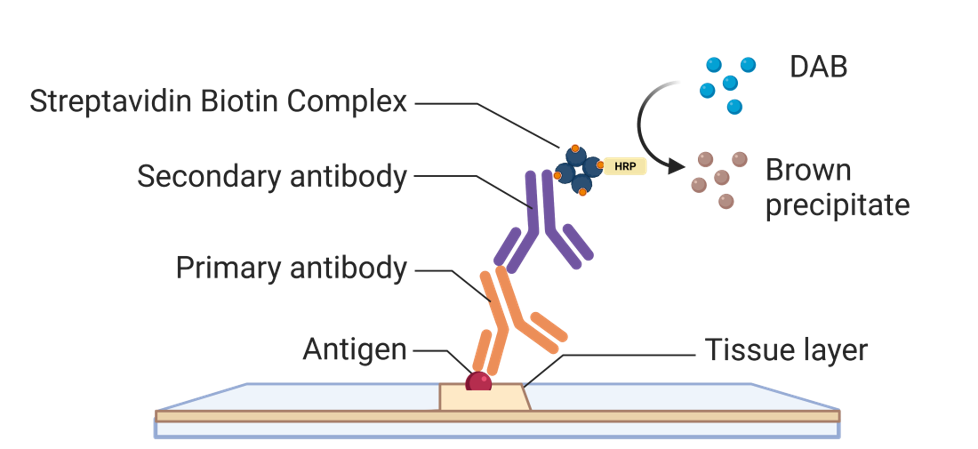Signal Amplification Using Chromogenic Detection

Chromogenic detection uses enzymes to convert soluble substrates to insoluble, chromogenic end products at the site of antigen expression. The two most common enzymes used for chromogenic detection are Horseradish peroxidase (HRP) and alkaline phosphatase (AP); HRP converts 3,3? diaminobenzidine (DAB) and 3-amino-9-ethylcarbazole (AEC), into brown and red end products, OriGene offers two types of detection systems: i) Traditional detection systems and ii) Polymer-linked detection systems.
Browse all traditional IHC Kits Browse all Polymer-Linked IHC Kits
- Streptavidin-Biotin Complex (ABC) Method
- Polymer-Linked Detection Method
- Advantages and Disadvantages of all Systems
- Selection Guide For OriGene Detection kits
Streptavidin-Biotin Complex (ABC) Method
The streptavidin-biotin complex (ABC) detection method is one of the most widely used methods for staining. Streptavidin is a tetramer with a high affinity for biotin; each streptavidin molecule can bind up to four biotin molecules. In the ABC system, streptavidin and biotinylated enzymes are combined to form a large complex that binds to a biotinylated target, usually a secondary antibody. The multilayer complex formed amplifies the signal generated by the antigen-antibody interaction, making it easier to detect and visualize low-abundance antigens. Usually, a secondary antibody conjugated with the complex attaches to tissue-bound primary antibodies; a substrate is then added and converted into a colored product to mark the target antigen.

Polymer Linked Detection Method
Polymer-based immunohistochemistry (IHC) methods are alternative techniques to the traditional streptavidin-biotin complex method. These polymer-based methods utilize enzyme-labeled polymer conjugates to amplify the signal generated by antigen-antibody interactions, similar to the streptavidin-biotin complex method. These methods offer increased sensitivity, reduced background staining, and simpler protocols.

Advantages Vs Disadvantages of Different Detection Method
| Advantages | Drawbacks | |
|---|---|---|
| ABC Method |
|
|
| Polymer Linked Method |
|
|
Selection Guide for OriGene IHC Detection Kits
| Detection System | Enzyme | Cost/ Assay | Biotin-Free | Polymer | Sensitivity | Amplification | Ready to use format | Typical number of steps |
|---|---|---|---|---|---|---|---|---|
| ABC System | HRP or AP | + | No | - | ++ | ++ | Blocking step required | 7 |
| Polink 1 | HRP or AP | ++ | Yes | + | ++ | ++ | Yes | 5 |
| Polink 2 | HRP or AP | ++ | Yes | + | +++ | +++ | Yes | 6 |
| Polink 2 Plus | HRP or AP | +++ | Yes | + | ++++ | ++++ | Yes | 6 |
| MultiStain Kits | HRP or AP | ++ | Yes | + | +++ | +++ | Yes | 7-15 |
| Klear Species Kit | HRP or AP | ++ | Yes | + | ++++ | ++++ | Yes | 7 |
| Assay Kit Resources |






























































































































































































































































 Germany
Germany
 Japan
Japan
 United Kingdom
United Kingdom
 China
China